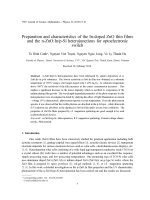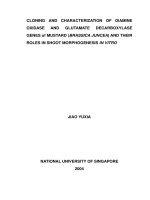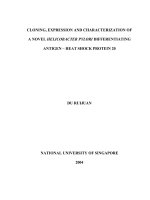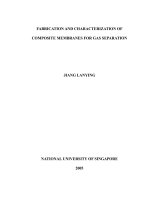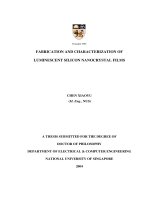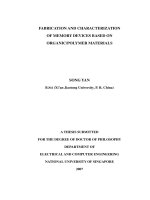Solution processed semiconducting and magnetic ni doped cuo thin films preparation and characterization
Bạn đang xem bản rút gọn của tài liệu. Xem và tải ngay bản đầy đủ của tài liệu tại đây (1.67 MB, 68 trang )
VIETNAM NATIONAL UNIVERSITY, HANOI
VIETNAM JAPAN UNIVERSITY
LA THI NGOC MAI
SOLUTION-PROCESSED SEMICONDUCTING AND
MAGNETIC Ni-DOPED CuO THIN FILMS:
PREPARATION AND CHARACTERIZATION
MASTER’S THESIS
VIETNAM NATIONAL UNIVERSITY, HANOI
VIETNAM JAPAN UNIVERSITY
LA THI NGOC MAI
SOLUTION-PROCESSED SEMICONDUCTING AND
MAGNETIC Ni-DOPED CuO THIN FILMS:
PREPARATION AND CHARACTERIZATION
MAJOR: NANOTECHNOLOGY
CODE: 8440140.11 QTD
RESEARCH SUPERVISORS:
Assoc. Prof. Dr. BUI NGUYEN QUOC TRINH
Prof. Dr. Sc. NGUYEN HOANG LUONG
Hanoi, 2021
Acknowledgement
First of all, I would like to sincerely thanks my two supervisors Assoc. Prof. Dr. Bui
Nguyen Quoc Trinh and Prof. Dr. Sc. Nguyen Hoang Luong for their unending support,
encouragement, and inspiration throughout my master course. Under their guidance, I
have had extensive knowledge and insight into materials science and nanotechnology,
including modern thin-film development, which helped me to gain a wholesome idea of
the field. I would always cherish the time I spent under their tutelage.
I would like to especially thank Assoc. Prof. Dr. Dang Van Thanh, who guided me
when I carried out experiments during my internship. I learned a lot from him in the
field of electrochemistry. His support and insightful comments aided me in completing
this research. Besides, I would like to thank Dr. Nguyen Quang Hoa, University of
Science, Vietnam National University, Hanoi, for allowing me to perform data analysis
and measurements in this study.
Moreover, I would like to give thanks to all the lecturers and researchers in
Nanotechnology Program, Vietnam Japan University, who have imparted useful
knowledge and supported me to accomplish this thesis.
I would express my thanks to Vietnam Japan University for providing me with the
facilities I am required to implement my project.
Last but not least, I especially wish to thank family members and friends who always
encourage and support me through the past 2-year master's course, to overcome any
difficulty.
This work is fully supported by the project with the code number of VJU.JICA.21.03,
from Vietnam Japan University, under Research Grant Program of Japan International
Cooperation Agency.
Hanoi, 2021
Master’s student
La Thi Ngoc Mai
TABLE OF CONTENTS
LIST OF TABLES ...........................................................................................................i
LIST OF FIGURES ........................................................................................................ ii
LIST OF ABBREVIATIONS ........................................................................................iv
INTRODUCTION ...........................................................................................................1
CHAPTER 1: OVERVIEW ............................................................................................ 3
1.1.
Dilute Magnetic Semiconductors (DMS) .......................................................3
1.2.
Thin film semiconductors ...............................................................................6
1.3.
Cupric oxide thin films ...................................................................................7
1.4.
Overview of deposition techniques ................................................................ 9
1.4.1.
Physical deposition techniques .............................................................. 10
1.4.2.
Chemistry deposition techniques ........................................................... 11
1.5.
Spin-coating techniques ................................................................................16
1.6.
Motivation and the objectives of the studies ................................................18
CHAPTER 2: FILM DEPOSITION AND CHARACTERIZATION .......................... 19
2.1.
Synthesis of precursors .................................................................................19
2.1.1.
Raw material .......................................................................................... 19
2.1.2.
Precursor preparation .............................................................................19
2.2.
Thin film deposition .....................................................................................20
2.2.1.
Substrate preparation .............................................................................20
2.2.2.
Deposition of Ni-doped CuO thin films ................................................21
2.3.
Film characterization ....................................................................................22
2.3.1.
X-ray diffraction (XRD) ........................................................................22
2.3.2.
Scanning electron microscopy (SEM) ...................................................25
2.3.3.
UV-Vis spectroscopy .............................................................................26
2.3.4.
Four-probe measurement system ........................................................... 27
2.3.5.
Electrochemical Impedance Spectroscopy (EIS) ..................................28
2.3.6.
Vibrating Sample Magnetometer (VSM) ..............................................30
CHAPTER 3: RESULTS AND DISCUSSION ............................................................ 33
3.1.
Reaction mechanism of precursor solution ..................................................33
3.2.
Analysis of Ni-doped CuO thin films on glass substrates ............................ 36
3.2.1.
Crystal-structure properties ...................................................................36
3.2.2.
Surface-morphology properties ............................................................. 38
3.2.3.
Optical properties ...................................................................................40
3.2.4.
Electrical properties ...............................................................................41
3.2.5.
Magnetic properties ...............................................................................42
3.3.
Analysis of Ni-doped CuO thin films on the ITO substrates .......................44
3.3.1.
Crystal-structure properties ...................................................................44
3.3.2.
Surface-morphology properties ............................................................. 45
3.3.3.
Optical properties ...................................................................................46
3.3.4.
Electrical properties ...............................................................................48
CONCLUSION .............................................................................................................51
REFERENCES ..............................................................................................................52
LIST OF TABLES
Table 1.1. High-temperature oxide-based DMS (adapted from ref. [15]). .....................5
Table 1.2. Crystallographic parameters (from ref. [32]). ...............................................7
Table 1.3. Thin film deposition methods (adapted from ref [47]). .................................9
Table 2.1. List of chemical compounds. .......................................................................19
Table 2.2. Mass of chemicals used to manufacture precursors with difference Ni doping
concentrations. ...............................................................................................................20
Table 2.3. Example of Nyquist graph and the usual equivalent circuit of a metal oxide
electrode [66] .................................................................................................................30
Table 3.1. Measured electrical characteristics of Ni-doped CuO thin films with 0, 0.2,
0.6, 1, 2, 3, and 4 wt.% of Ni doping on the glass substrates. .......................................41
i
LIST OF FIGURES
Figure 1.1. Schematic showing a magnetic semiconductor (A), a non-magnetic
semiconductor (B), and a diluted magnetic semiconductor (C) [4]. ............................... 4
Figure 1.2. Schematic diagram of sputtering [47]. .......................................................10
Figure 1.3. Sol-gel process [54]....................................................................................12
Figure 1.4. Schematic of a chemical bath deposition [56]. ..........................................14
Figure 1.5. The SILAR deposition process [58]........................................................... 15
Figure 1.6. The stages of thin film formation using spin-coating process [60]. ..........17
Figure 2.1. Precursor solution preparation process. .....................................................20
Figure 2.2. Spin-coating system (a), annealing furnace (b). ........................................22
Figure 2.3. Electromagnetic radiation spectrum. .......................................................... 23
Figure 2.4. Diffraction of X-rays by a crystal. ............................................................. 24
Figure 2.5. Schematic diagram of a Scanning Electron Microscope [62] (a), SEM
machine in this study (b). .............................................................................................. 25
Figure 2.6. Schematic of four-point probe configuration. ............................................27
Figure 2.7. Model of an electrochemical electrode system and its equivalent electrical
circuit [65]. ....................................................................................................................29
Figure 2.8. VSM system. .............................................................................................. 31
Figure 2.9. Hysteresis loop (M-H curve) of the magnetic materials [67]. ...................32
Figure 3.1. The change of concentration, solvent, additive, and Ni2+: MEA ratio to the
solubility of nickel salt. .................................................................................................33
Figure 3.2. CuO precursor solution (a), and Ni-doped CuO precursor solution in the
range 0 – 4 wt.% Ni doping (b). ....................................................................................34
Figure 3.3. Schematic drawing of the chemical equilibria involved in the Ni and Cu ions
sol-gel process. ..............................................................................................................35
Figure 3.4. XRD patterns of the un-doped and Ni-doped CuO thin films on glass
substrates. ......................................................................................................................36
Figure 3.5. The XRD patterns in the range 30° - 40° of the films on the glass substrates.
.......................................................................................................................................37
Figure 3.6. Surface SEM images of Ni-doped CuO thin films with various Ni ratios on
glass substrates. .............................................................................................................39
Figure 3.7. The optical absorbance graph of Ni-doped CuO films on glass substrates.
.......................................................................................................................................40
Figure 3.8. The optical bandgap versus Ni doping concentrations of Ni-doped CuO
films on glass substrates. ............................................................................................... 41
Figure 3.9. M-H curves of the Ni-doped CuO thin films on glass substrates. .............43
Figure 3.10. M-H curves for NiO powder and Ni-CuO film........................................43
Figure 3.11. XRD patterns (a), the enlarged diffraction pattern in the range 35° to 40°
(b) of all films on the ITO substrates.............................................................................45
ii
Figure 3.12. SEM images of CuO thin film and Ni-doped CuO thin films with 1, 2, 3,
4 wt.% deposited on the ITO substrates. .......................................................................46
Figure 3.13. Optical absorbance spectra of all films on the ITO substrates. ................47
Figure 3.14. Variation of bandgap energy for un-doped and Ni-doped CuO thin films
on the ITO substrates. ....................................................................................................48
Figure 3.15. Nyquist plot (a), the equivalent circuit model (b) of the Ni-doped CuO
thin films on the ITO substrates. ...................................................................................49
Figure 3.16. Variation in the resistive part with frequency of the undoped and Ni- doped
CuO thin films on the ITO substrates. ...........................................................................49
iii
LIST OF ABBREVIATIONS
CBD
: Chemical bath deposition
CVD
: Chemical vapor deposition
DMS
: Dilute magnetic semiconductor
FE-SEM
: Field emission scanning electron spectroscopy
MEA
: Monoethanolamine
RTFM
: Room temperature ferromagnetism
SEM
: Scanning electron spectroscopy
SILAR
: Successive ionic layer adsorption and reaction
SQUID
: Superconducting quantum interference device
UV-VIS
: Ultravilolet-Visible
VSM
: Vibrating sample magnetometer
XRD
: X-ray diffraction
iv
INTRODUCTION
Conventionally, electronic devices use an electron state, which is an electrical
charge for information processing. One method for increasing information storage
capacity and signal processing speed in electronic devices is to reduce the size of
electronic components such as transistors or capacitors. Both coding and decoding
processes will face extreme difficulty as the size of the transistor cell continues to be
shrunk due to the quantum effect. The spintronic device is a candidate technology for
addressing the major issues found in conventional electronic devices. The spintronic
device combines charge-based semiconductor property with magnetic property based
on spin effect to carry and store information in a single device.
Dilute Magnetic Semiconductor (DMS) is one of the most interesting materials for
the development of spintronic devices containing the functional features mentioned
above. The advantages of spin-based DMS application are to improve integration
density and higher data processing speed, higher efficiency, low power consumption,
and better stability. Therefore, researchers are always seeking DMS materials with
magnetic behavior at room temperature, so that they can be manufactured in the
electronics field.
The p-type semiconductor cupric oxide (CuO) has antiferromagnetic characteristics.
In addition, CuO has a good light absorption coefficient with low thermal emittance.
The characteristic properties of CuO thin films such as photoelectric properties, crystal
structure can be controlled by doping, annealing temperature, crystallization atmosphere,
and so on. So far, several studies have focused on the magnetic behaviors of CuO in
combination with different magnetic ions. However, there are still a lot of remaining
rooms to search for novel materials for the electronic device application.
In this thesis, CuO thin films doped with transition metal ions Ni were fabricated by
the solution-processed method. Using the spin-coating process, thin films with various
Ni doping ratios were coated on glass and ITO substrates. The structural, morphological,
optoelectrical and magnetic characteristics of the thin films are all studied. The
achievement results pointed out that the Ni-doped CuO films obtained can be considered
1
for a channel of thin film transistors or the applications in spintronic devices and noise
suppressors.
2
CHAPTER 1: OVERVIEW
1.1.
Dilute Magnetic Semiconductors (DMS)
Spintronics, also known as spin electronics, is one of the next-generation fields in
electronics that studies the spin and charge states of an electron [1]. By combining the
spin of electrons with their charge, spintronic systems are most commonly realized in
applications of existing electronic devices. Spin-electronics consume less power and
have larger memory and computing power in a smaller size than conventional electronic
devices.
Conventional magnetic storage devices used passive magnetoresistive sensors and
memory elements comprised of ferromagnetic 3d metal alloy electrodes. The discovery
of
enormous
magnetoresistance,
in
(Fe/Cr)n
multilayers,
and
tunneling
magnetoresistance later aided their growth [2]. In fact, magnetic semiconductors are
difficult to develop in practical applications, as they exhibit ferromagnetic properties at
low Curie temperatures, frequently below 100 K [3]. Thus, scientists have searched for
and developed a new magnetic semiconductor material called diluted magnetic
semiconductors (DMS) by adding a few percent of magnetic atoms to the structure of
the non-magnetic semiconductor material.
DMS, also known as semimagnetic semiconductors, are materials in which a few
percent of magnetic elements substitute some of the cations in a host semiconductor.
Semi-magnetic semiconductors have characteristics that differ from classical magnetic
semiconductors, are distinguished by a regulated dilution of the magnetic part (Figure
1.1).
In the DMS, the charge carriers of the electron state strongly interact with the local
magnetic moments, resulting in the material's unique physical features. Magnetic ions
can affect the state of the semiconductor band when the DMS material is applied by an
external magnetic field. The arrangement of the spins of the magnetic ions is affected
by the applied magnetic field, which has an effect on the spins of the band electrons.
Magnetic enhancement of magnetic ions onto semiconductors in this way, leading to
giant magneto-optical effects, makes DMS materials even more interesting.
3
Figure 1.1. Schematic showing a magnetic semiconductor (A), a non-magnetic
semiconductor (B), and a diluted magnetic semiconductor (C) [4].
Metal transition doped compound semiconductors based on II-VI semiconductors
are used to make DMS such as InMnAs [5] and GaMnAs [6]. Hole formation occurs
when divalent metal ions replace trivalent metal ions in III-V semiconductor
semiconductors, resulting in ferromagnetic order intermediates. GaMnAs have been
chosen as a material in many spin-based device applications, including spin-polarized
light emitters [7], and spin field-effect transistors [8] which exhibit a magnetic behavior
at below room temperature (TC = 173 K) [9]. Therefore, these semiconductor
compounds can only function at cold temperatures (T ~ 100 K), making II-VI DMS
unsuitable for practical electronic applications.
For the applications of DMS materials in electronics devices, achieving roomtemperature ferromagnetism (RTFM) has become a critical problem. Several
experimental results over RTFM have been reported in recent years in several classes of
DMS, including wide bandgap III-V semiconductors (GaN, GaP) and group IV
semiconductors (Ge, Si) [10]. Ferromagnetism has been shown to be carrier-mediated,
allowing magnetic behavior to be modified through charge manipulation. This has
elevated oxide-based DMS to the status of critical material in the creation of electrical
devices. Furthermore, the majority of oxide-based DMSs are a type of large bandgap
semiconductors (> 3 eV), which can provide an optoelectronic dimension to the next
generation of spintronic devices. Several recent studies have investigated DMS oxide
exhibiting ferromagnetic properties at room temperature. The ferromagnetic
characteristics of Co-doped TiO2 material revealed for the first time by Matsumoto et al.
4
[11, 12], have gotten a lot of attention. Table 1.1 summarizes the magnetic moments and
TC values published in the literature for these DMS-based thin films. Following that,
numerous scientists discovered the ferromagnetic properties of ZnO doped with
transition metals at ambient temperature [13, 14].
Table 1.1. High-temperature oxide-based DMS (adapted from ref. [15]).
Material
Doping
Moment
TC (K)
Ref
(μB/3d ion)
TiO2
1-2% Co
0.3
> 300
[11]
7% Co
1.4
650 - 700
[16]
5% V
4.2
> 400
[17]
2% Fe
2.4
> 300
[18]
10% Co
2.0
280 – 300
[19]
15% V
0.5
> 350
[20]
2.2% Mn
0.16
> 300
[13]
5% Fe – 1% Cu
0.75
550
[21]
0.9% Ni
0.06
> 300
[22]
5% Co
7.5
650
[23]
5% Fe
1.8
610
[24]
Cu2O
5% Co – 0.5% Al
0.2
> 300
[25]
CuO
4.7% Ni
0.3
> 300
[26]
ZnO
SnO2
More researches have recently been conducted on other promising metal oxides due
to their intriguing properties. Copper (II) oxide (CuO) is a semiconductor material with
interesting properties suitable for DMS fabrication research. CuO is a high critical
temperature superconductor because superconductivity in these systems is associated
with Cu-O bondings [27, 28]. As a result, studying the magnetic characteristics of nanosized CuO materials is extremely important.
CuO doped with various transition metals (Co, Fe, and Ni) can exhibit the
ferromagnetic order with TC above room temperature. According to Li et al. [29], the
ferromagnetic interaction between the doped Fe ions randomly distributed in the
antiferromagnetic CuO structure produces materials with magnetic properties at Curie
5
temperatures over 400 K. Layek and Verma [30] observed all of the Fe-doped CuO
matrix samples exhibited ferromagnetic behaviors at room temperature. Moreover,
Dolai et al. [26] demonstrated ferromagnetism in Ni-doped CuO thin films formed via
spin-coating deposition with magnetization observed being temperature independent
between 20 K and 330 K.
1.2.
Thin film semiconductors
Thin film semiconductors have seen rapid growth in many years, with the
commercialization of a wide variety of products. Such structures are commonly found
in many electronic materials, including transistors, and photovoltaic devices.
Semiconductor thin films, ranging in thickness from a few nanometers to hundreds of
micrometers, are used in a variety of applications, and the manufacturing technique has
a direct impact on their structural and physicochemical features [31]. Because of its wide
range of properties, semiconductor thin films can easily become a promising ideal
material in the electronic materials industry. By varying the fabrication method, as well
as varying the substrate and other manufacturing parameters, it is possible to easily grow
single or polycrystalline structures on substrates with complex surface morphology.
These films are classified as single-crystalline, polycrystalline, or amorphous.
Single-crystalline thin films
Single-crystalline thin films are usually grown on suitable single-crystalline
substrates. The properties of single-crystalline films are exactly the same as those of
single-crystal bulk material but are affected by the presence of the surface. They are
used in many optoelectronic devices such as heterojunction solar cells, light-emitting
diodes.
Polycrystalline thin films
Polycrystalline thin films can be distinguished from bulk by their grain-oriented
plane arrangement. Polycrystalline material grains may have a variety of shapes and
sizes. There are many applications developed from polycrystalline thin film
semiconductors including gate electrodes in MOSFETs, thin-film transistors, and solar
6
cell devices. The polycrystalline films have structural flaws including grain boundaries
and randomly oriented crystals.
Amorphous thin films
Since the atoms in amorphous thin films are uniformly ordered, they lack the usual
solid-state properties of crystalline materials. They also found use in metallurgy,
semiconductor products, and other areas.
1.3.
Cupric oxide thin films
Cupric oxide, also known as copper (II) oxide (CuO), is one of two copper oxide
phases, the other being cuprous oxide (Cu2O). CuO has a monoclinic symmetry in its
lattice. The Cu atom is bound to the four nearest oxygen atoms, putting the copper atom
in the rectangle's center and the oxygen atoms in the copper deformed tetrahedron's core.
Table 1.2 lists crystallographic parameters as well as interatomic distances to nearest
neighbors.
Table 1.2. Crystallographic parameters (from ref. [32]).
CuO
Lattice parameter
Monoclinic
a = 4.6837 Å
b = 3.4226 Å
c = 5.1288 Å
β = 99.54°
Shortest distances
dCu – O
1.95 Å
dO – O
2.62 Å
dCu – Cu
2.90 Å
CuO is an antiferromagnetic semiconductor with an open d shell (3d9) [32]. CuO is
a p-type semiconductor because of the formation of copper vacancies as acceptors in the
CuO lattice. Intrinsic defects (copper or oxygen vacancies) mainly affect the electrical
properties of pure CuO [33]. Owing to the instability of copper, copper vacancies are
well recognized to be the most prevalent defects in a nonstoichiometric cupric oxide [34,
7
35]. The mobility variation for the estimated free carriers concentration and the hole is
1010 to 1016 cm-3 and 10 to 100 cm2V-1s-1, respectively [36]. In fact, the crystal lattice is
not flawless and some defects. Thin film’s electrical properties are affected by structural
changes due to phase transitions, doping, and uniform grain boundary expansion. The
number of charge carriers and their mobility are both affected by these variations, which
have a direct impact on the film's resistivity. Furthermore, several investigations have
revealed that changing the annealing temperature causes the film's electrical
conductivity to change. Saravanakannan et al. [37] showed the electrical properties were
affected by the annealing temperature and discovered that increasing the annealing
temperature from 523 K to 723 K decreased the resistivity.
The optical characteristics of thin films have a significant impact on the fabrication
of optoelectronic devices, and this is a critical parameter. The direct narrow bandgap of
bulk cupric oxides (CuO) is 1.2 eV. However, depending on the deposition procedures
and factors affecting thin film quality, the optical bandgap in CuO thin films can range
1.3 ~ 1.9 eV [38, 39]. Some factors that can affect the bandgap energy of CuO films are
doping concentration, thickness, grain size, and structural change. The bandgap energy
of CuO films generated via successive ionic layer adsorption and reaction (SILAR)
decreased as the film thickness increased, according to Singh et al. [40].
CuO is an antiferromagnetic semiconductor with two Neel temperatures:
TN1 = 231 K and TN2 = 212 K [41]. The magnetic structure of CuO is strongly
antiferromagnetic, consisting of Cu–O parallel sheets.
Because of its intriguing surface chemistry, great recyclability, non-toxicity,
greater optical absorbance, and comparatively low cost of raw ingredients, CuO has
attracted substantial interest [42, 43]. A number of transition metals were utilized as
dopants in CuO nanostructures to adjust the characteristics of CuO to suit the
requirements for desired applications. These transition metal ions aided the electron in
the excitation of photon absorption by forming new energy levels between the
conduction and valence bands [44, 45]. Furthermore, doping transition metals into the
CuO structure has an impact on CuO solar cell efficiency [46].
8
1.4.
Overview of deposition techniques
Thin film has attracted a lot of attention because they have a lot of remarkable
features and are useful in science, industry, and commerce. Thin film technology is used
to produce materials with nanoscale dimensions and thicknesses that are ideal for the
production of electronic devices with small sizes in optoelectronic devices. There are
two popular deposition procedures for producing high-quality thin films: physical and
chemical depositions, which use different types of precursors. It is possible to
summarize it as stated in Table 1.3.
Table 1.3. Thin film deposition methods (adapted from ref [47]).
Physical deposition
1. Evaporation techniques
Chemical deposition
1. Sol-gel techniques
a. Vacuum thermal evaporation
2. Chemical bath deposition
b. Electron beam evaporation
3. Spray pyrolysis technique
c. Laser beam evaporation
4. Plating
d. Arc evaporation
a. Electroplating technique
e. Molecular beam epitaxy
b. Electroless deposition
f. Ion plating evaporation
2. Sputtering techniques
a. Direct
current
sputtering
(DC sputtering)
b. Radio frequency sputtering
5. Chemical
vapor
deposition
(CVD)
a. Low pressure (LPCVD)
b. Plasma enhanced (PECVD)
c. Atomic layer deposition (ALD)
(RF sputtering)
The doping of transition metals in CuO thin films can affect the surface and physical
properties of the thin films. Nickel is one of the transition metals used as a dopant,
affecting the structure and electro-optical characteristics of CuO. A variety of physical
and chemical techniques, such as sol-gel [26, 48, 49], and successive ion layer
adsorption and reaction (SILAR) [50], and sputtering technique [51], have been used to
fabricate Ni-doped CuO thin films.
9
1.4.1. Physical deposition techniques
Sputtering is a thin-film production technology utilized in a wide range of industries.
A vacuum chamber is used to form the film. A vacuum chamber is used to form the film.
A voltage is supplied between the cathode's target material (source) and the anode's
substrate material (destination). Plasma is commonly created using inert gases such as
argon or xenon. These inert gases are widely employed as sputtering gases since they
do not interact with the target material other gases. A thin film is formed when
bombardment ions impact the anode or the substrate. The sputtering system is
represented in Figure 1.2 as an illustration.
Sputtering technique is divided into two common types based on the plasma
formation process: direct current (DC) and radio frequency (RF). Besides, DC sputtering
is commonly employed for conductive target materials such as metals because it is easy
to adjust and consumes relatively little power. RF Sputtering has been created to replace
or pulse the sputtering energy source to neutralize the target surface and prevent it from
generating a positive charge for dielectric-insulating target materials.
Figure 1.2. Schematic diagram of sputtering [47].
Sputtering technique has various advantages.
1) On large substrates, sputtering can deposit thin films of uniform thickness.
2) The thin film produced is impurity-free and of high quality.
10
3) By adjusting the operating parameters and modifying the deposition time, the
film thickness can be conveniently controlled.
The main disadvantage of ion beam sputtering is that the sputtering equipment is
extremely complicated with high-cost equipment, and high purity source material is
required. In addition, it requires users with highly specialized skills. Furthermore, ion
beam sputtering is ineffective for producing uniformly thick large-area films.
RF sputtering is used to deposit Ni-doped CuO thin films reported by Aakib and
colleagues [51]. The resulting Ni-doped CuO film has a polycrystalline structure with a
dominant peak in the (111) direction. The crystal size and resistivity of CuO thin films
have been shown to be affected by nickel doping. The energy bandgap increases from
1.62 to 1.76 eV when Ni ions concentration increases within 0 and 4.5 at.%. P-type
conduction can be seen in all of the films, and the resistivity varies depending on the
nickel material.
1.4.2. Chemistry deposition techniques
The chemical deposition is a popular technology in the semiconductor thin film
industry because of its cost-effectiveness and high-quality process. Sol-gel, chemical
vapor deposition (CVD), chemical bath deposition, and spray pyrolysis are the most
popular chemical deposition techniques. This section will introduce sol-gel and CVD
techniques since they produce high-quality films with minimal equipment.
1.4.2.1.
Sol-gel technique
Sol-gel technology is a wet-chemical technique that synthesizes solid materials from
small molecules. Sol-gel is a combination of micro particles or molecules in solution
(sols) that agglomerate together under particular conditions and metal-oxygen-metal
bonds together to form a bonding network (gels) [52, 53]. Furthermore, when
condensation occurs completely, sol particles form in an inorganic network known as a
gel. The sol-gel technique's bottom-up method has the advantage of low energy
consumption at an effective cost, as well as good chemical composition control in a
simple operation, which is particularly practical on a laboratory or industrial scale.
11
Figure 1.3. Sol-gel process [54].
A precursor solution is prepared using the sol-gel process, which is subsequently
utilized to form a thin film. Thin coatings are thin layers of raw materials that can be
functionalized and applied to a substrate such as metal, glass, crystals, or ceramics to
change its optoelectrical properties. Thin films with thicknesses ranging from
micrometer to nanometer can be synthesized. Dip coating and spin coating are the
common methods for depositing thin films from sol-gel solutions (Figure 1.3).
In dipping and spinning techniques, parameters such as spinning speed, surface
tension, solution viscosity, and solvent evaporation rate have a significant impact on
thin film formation. Spin-coating is a technique of forming a homogeneous film
deposited on a solid substrate by using radial force. Because of the strong interaction of
radial and frictional forces of the solution viscosity, the film deposited by spin-coating
generates a uniform thickness on the substrate. This shows that spinning coatings offer
more advantages over dip coatings.
The CuO and Ni-doped CuO thin films were successfully produced as described by
Baturay et al. [48] through spin-coating method. The XRD pattern indicates that all films
12
had a polycrystalline tenorite structure. The presence of nanoparticles on the flat surface
increased as the doping level increased as observed by SEM images. The electrical
properties were analyzed using a Hall effect system, which showed that CuO is a
conductive substance that is p-type. When Ni doping was increased to 6%, the bandgap
energy Eg reduced slightly between 2.03 eV and 1.96 eV, and then Eg increased to 2.22
eV with 10% Ni doping.
In the report by Dolai et al. [26], Superconducting quantum interference device
(SQUID) measurements were used to analyze the magnetic characteristics of Ni-doped
CuO thin films. Between 20 K and 330 K, magnetization was found to be basically
temperature independent. The residual magnetization and coercive field in CuO-based
films were calculated with the change of doped nickel content.
1.4.2.2.
Modified chemical bath deposition technique
Chemical bath deposition (CBD) is a technique for depositing films on substrates
by immersing the substrate (once or several times) in a precursor solution. Controlling
the solution's temperature, pH, and concentration causes a solid phase to dissolve and
generate a film on the substrate. Salts of medium to high water solubilities, such as
chlorides, nitrates, sulfates, or acetates, are used as the deposition medium. In solution,
the chemical reaction proceeds slowly, resulting in the creation of a solid substance on
the substrate. This method can be used to produce coatings for materials that aren't
resistant to high temperatures, such as polymers [55]. Immersion of substrates in liquids
allows for the coating of complex surfaces such as powders, tubes, and porous structures,
which are difficult to coat with spray or vapor deposition processes. CBD equipment is
easy to use, and it can be manufactured in large quantities and processed on a continuous
basis. A schematic diagram of the chemical bath deposition technique is shown Figure
1.4.
13
Figure 1.4. Schematic of a chemical bath deposition [56].
However, this method is still difficult to use in the synthesis of multicomponent
materials whose individual components precipitate at vastly different temperatures or
pH levels. Furthermore, the CBD process converts precursor materials into deposits less
efficiently. In solution, heterogeneous nucleation on the substrate surface is possible. As
a result, slow-growing granules form films. This difficulty is prevented by forming seed
layers on a pre-treated substrate.
A modified CBD system was suggested by Ha et al. [57] for uniform Ni-doped CuO
film formation. A seed layer was coated on the substrate using spin-coating method.
After the film crystallizes, the seeds continued to grow on the substrate by immersing
them in the precursor solution. When the Ni doping ratio was increased to 5%, the
nanorod structure got thicker, as shown by FE-SEM images. The formation of the
nanorod structure was slowed with an increased 20% Ni doping. In addition, the
bandgap energy value of the films increased from 2.33 to 3.46 eV with increasing 20%
Ni doping. The results of the XRD analysis revealed that there was no Ni-related phase
present. The Ni doping also significantly affected the photoelectrochemical
characteristics of the CuO nanorod structure.
14
1.4.2.3.
Successive ionic layer adsorption and reaction technique
The successive ionic layer adsorption and reaction (SILAR) technique is a modified
method from Chemical bath deposition method. Both the SILAR and CBD techniques
involve ion deposition on the immersion surface in cation and anion baths. The CBD
method keeps the substrate in a chemical bath containing both cationic and anionic
solutions while forming a thin film. Meanwhile, the substrates were immersed in
separate solutions of cationic and anionic precursors in the SILAR method. The CBD
method leaves a precipitate on the chemical tank's walls as well as a large amount of
waste material. The SILAR technique can also be used to perform metal ion doping at
low temperatures.
SILAR provides a number of advantages. By simply adding dopant ions to a cationic
solution, it is possible to produce films doped with practically any component in any
ratio. In addition, room-temperature film formation can grow films on less stable
materials, and the deposition rate and the film thickness can be regulated by modifying
the deposition cycles.
Figure 1.5. The SILAR deposition process [58].
The SILAR method uses ionic adsorption to react ions from the precursor solution,
as well as deionized water to rinse the solution between immersion to prevent uniform
precipitation. Figure 1.5 illustrates the SILAR deposition mechanism. Dip in a cationic
15
solution, wash in purified water, then dip in an anionic solution and wash in purified
water are all steps in the SILAR process.
The SILAR process's growth mechanism consists of three major steps [59]:
(i)
The substrate is immersed in a cationic solution to form a layer for film
growth.
(ii)
Water rinsing to remove excess solution from the substrate surface
(iii)
After immersing the substrate in the anionic precursor solution, a chemical
reaction occurs between the well-adhered cations of the substrate surface and
the anions in the precursor solution, forming the appropriate compound.
Das and Mitra [50] deposited Ni-doped CuO thin films by the SILAR method on
glass substrates. They analyzed the effect of nickel ions on the electrical properties,
dielectric process, and impedance characteristics of CuO-based thin films. The XRD
analysis revealed a decrease in grain size at concentrations up to 6% Ni ions. Impedance
spectroscopy research indicates an increase in AC conductivity and the resistivity
component of the dielectric constant after doping 6% Ni, indicating enhanced carrier
density.
1.5.
Spin-coating techniques
Spin-coating is a technique for depositing films in a continuous pattern onto a flat
surface. The radial force and surface tension of the liquid combine to produce a uniform
coating when a small amount of precursor solution is put to the substrate surface. Thin
films can range in thickness from a few nanometers to many micrometers.
The spin coating method is one of the popular deposition techniques because of its
fast, cheap and simple method for producing homogeneous samples. Furthermore, this
method has the great advantage of developing extremely uniform sample layers on
different substrates. Film thickness is affected by a number of conditions such as the
spin speed and the viscosity photoresists. In addition, this method does not require strict
pressure, power, and manufacturing engineering conditions compared to the vacuum
method.
16

